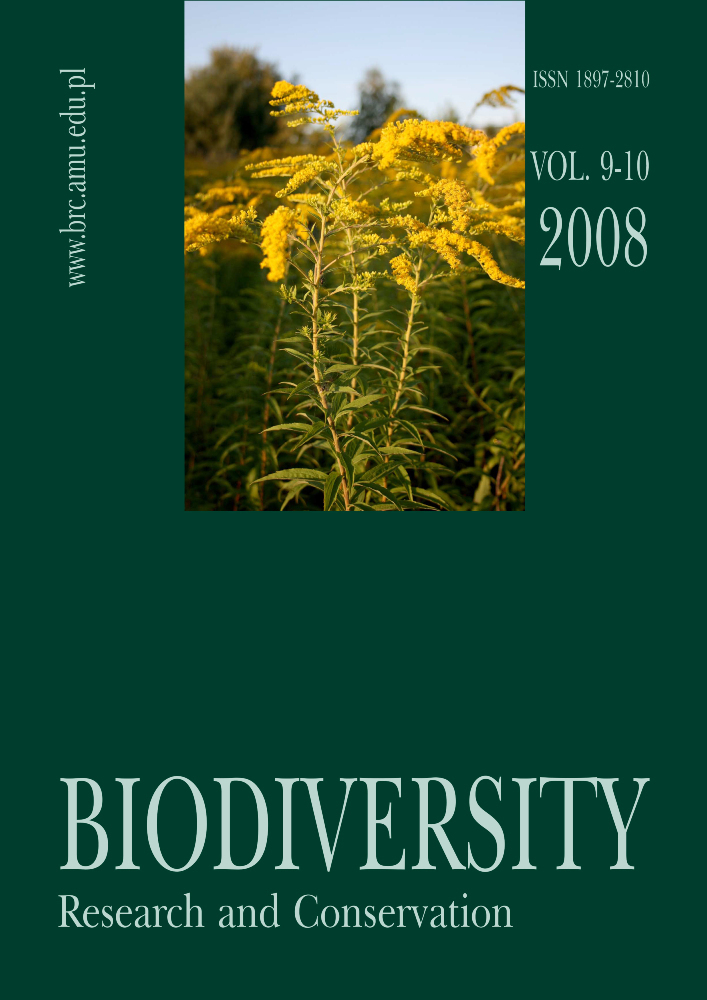Abstract
The protected landscape area of “The Odra River Meanders” is located in the south-west part of the province of Silesia, along the Odra river, on the border with the Czech Republic. This meandering fragment of the Odra river is one of the few places in Europe where natural geomorphological processes are still preserved. During botanical investigations, the occurrence of 363 vascular plant species was confirmed, including 95 species of alien origin. The participation of archaeophytes was 12%, kenophytes 10% and diaphytes 4%. A high participation of these groups of species was noted in habitats transformed by human activities, such as fields, roadsides and hedges, as well as in natural ones, such as steep escarpments and gravel sandbanks which have been shaped by the dynamic flow of the river. The first group of habitats was characterised by the highest proportion of archaeophytes, whereas in more natural habitats, the ascendancy of kenophytes (= neophytes) over older adventives was noted, e.g. the most common and widespread in this area were species from the Reynoutria (Fallopia) genus. The number of alien species in each habitat type was quite high and ranged from 1 to 62.
References
Act on Nature Protection of 16 April 2004. Journal of Laws No 92 (2004), item 880.
Annex I of Council Directive (92/43/EEC) of 21 May 1992 on the conservation of natural habitats and of wild fauna and flora (OJ L 206, 22.7.1992, p. 7). Natural habitat types of community interest whose conservation requires the designation of special areas of conservation.
BAILEY J. & SCHNITZLER A. 2003. La renouée du Japon, une dangereuse conquęte de l’Ouest. La Recherche 5: 50-55.
European Ecological Natura 2000 NETWORK. 2008. Informacja o statusie projektowanych specjalnych obszarach ochrony siedliska Natura 2000. natura2000.mos.gov.pl
FALIŃSKI J. B. 2000. Rzeczne wędrówki roślin. In: J. KUŁTUNIAK (ed.). Kultura - cywilizacja - historia, 9, pp. 143-184. Wyd. Nauk. Śląsk, Katowice.
FALIŃSKI J. B. 2004. Inwazje w świecie roślin: mechanizmy, zagrożenia, projekty badań. Phytocoenosis 16 (N.S.), Sem. Geobot. 19: 1-31. Warszawa-Białowieża.
JANKOWSKI W. & ŚWIERKOSZ K. 1995. Korytarz ekologiczny doliny Odry. Stan - Funkcjonowanie - Zagrożenia. Fundacja IUCN Poland, Warszawa.
KORNAŚ J. 1968. Geograficzno-historyczna klasyfikacja roślin synantropijnych. In: J. B. FALIŃSKI (ed.). Synantropizacja szaty roślinnej. I. Neofityzm i apofityzm. Mater. Zakł. Fitosoc. Stos. UW Warszawa-Białowieża 25: 33-41.
KORNAŚ J. & MEDWECKA-KORNAŚ A. 2002. Geografia roślin, wyd. 2, 634 pp. Wyd. Nauk. PWN, Warszawa.
KOSZELA K. 2008. Stan i zagrożenia Obszaru Chronionego Krajobrazu „Meandry rzeki Odry” M. Sc. Thesis, University of Silesia, Katowice.
KUCHARCZYK M. 2003. Phytogeographical Roles of Lowland Rivers on the Example of the Middle Vistula. 127 pp. Maria Curie-Skłodowska University Press, Lublin.
MIREK Z., PIĘKOŚ-MIRKOWA H., ZAJĄC A. & ZAJĄC M. 2002. Flowering plants and pteridophytes of Poland. A checklist. In: Z. MIREK (ed.). Biodiversity of Poland 1, 442 pp. W. Szafer Institute of Botany, Polish Academy of Sciences, Kraków.
NIEZNAŃSKI P. (ed.). 2006. Nasza Odra. Przewodnik turystyczno-przyrodniczy po granicznych meandrach Odry. WWF Polska, Urząd Gminy Krzyżanowice.
OBRDLÍK P. 2003. Graniczne meandry Odry – fenomen o znaczeniu europejskim (raport za okres od marca 2001 do kwietnia 2003). WWF-Auen-Institut, Rastatt.
RAST G., OBRDLÍK P. & NIEZNAŃSKI P. (eds.). 2000. Atlas zalewowych obszarów Odry. WWF-Deutschland, WWF-Auen-Institut.
REJMÁNEK M., RICHARDSON D. M. & PYŠEK P. 2005. Plant invasions and invasibility of plant communities. In: E. VAN DER MAAREL (ed.). Vegetation ecology, pp. 332-355. Blackwell Science, Copyright Blackwell Publishing Ltd, Oxford.
RICHARDSON D. M., HOLMES P. M., ESLER K. J., GALATOWITSCH S. M., STROMBERG J. C., KIRKMAN S. P., PYŠEK P., HOBBS R. J. 2007. Riparian vegetation: degradation, alien plant invasions, and restoration prospects. Diversity Distrib. 13: 126-139.
SCHNITZLER A., HALE B. W. & ALSUM E. M. 2007. Examining native and exotic species diversity in European riparian forests. Biological conservation 138: 146-156.
TOKARSKA-GUZIK B. 2003. Habitat preferences of some alien plants (kenophytes) occurring in Poland. In: A. ZAJĄC, M. ZAJĄC & B. ZEMANEK (eds.). Phytogeographical problems of synanthropic plants, pp. 75-83. Institute of Botany, Jagiellonian University, Cracow.
TOKARSKA-GUZIK B. 2005a. The Establishment and Spread of Alien Plant Species (Kenophytes) in the Flora of Poland. Prace naukowe Uniw. Śląskiego w Katowicach 2372: 1-192.
TOKARSKA-GUZIK B. 2005b. Invasive ability of kenophytes occurring in Poland: a tentative assessment. In: W. NENTWIG, S. BACHNER, M. J. W. COCK, H. DIETZ, A. GIGON & R. WITTENBERG (eds.). Biological Invasions - From Ecology to Control. Neobiota 6: 47-65.
TOKARSKA-GUZIK B., BZDĘGA K., KNAPIK D. & JENCZAŁA G. 2006. Changes in plant species richness in some riparian plant communities as a result of their colonisation by taxa of Reynoutria (Fallopia). Biodiv. Res. Conserv. 1-2: 123-130.
TOKARSKA-GUZIK B., BZDĘGA K. & KOSZELA K. 2007. Zróżnicowanie gatunkowe flory i zagrożenia wywołane inwazyjnymi gatunkami roślin na obszarze chronionego krajobrazu polsko-czeskich meandrów Odry. W: J. A. LIS & M. A. MAZUR (eds.). Przyrodnicze wartości polsko-czeskiego pogranicza jako wspólne dziedzictwo Unii Europejskiej, pp. 151-166. Centrum Studiów nad Bioróżnorodnością, Katedra Biosystematyki, Uniwersytet Opolski, Opole.
TOKARSKA-GUZIK B. & DAJDOK Z. 2004. Rośliny obcego pochodzenia - udział i rola w szacie roślinnej Opolszczyzny. In: A. NOWAK & K. SPAŁEK (eds.) Ochrona szaty roślinnej Śląska Opolskiego, pp. 277-303. Wyd. Uniw. Opolskiego, Opole.
TOKARSKA-GUZIK B., ZAJĄC A. & ZAJĄC M. 2008. Geographical and ecological aspects of the spread of alien plant species in Poland. In: W. RABITSCH, F. ESSL & F. KLINGENSTEIN (eds.). Biological Invasions – from Ecology to Conservation. Neobiota 7: 143-152.
License
Copyright © by Adam Mickiewicz University, Poznań, Poland, Department of Plant Taxonomy, 2008OPEN ACCESS




